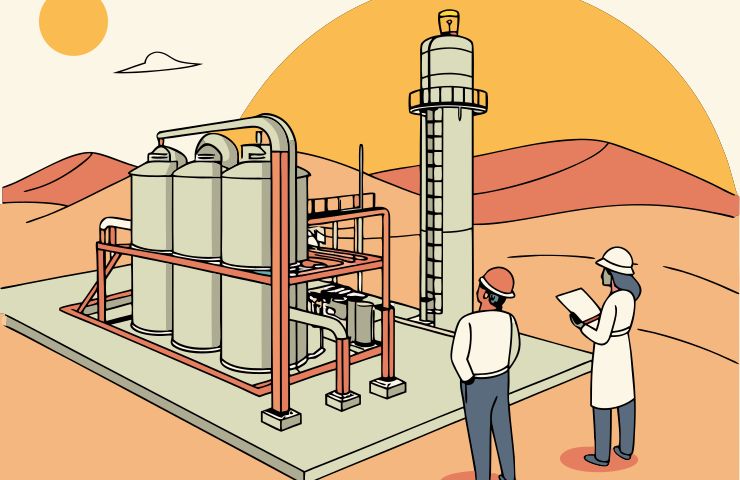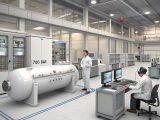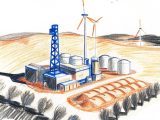
Hydrogen Production: HRU Adds 6% Ammonia Output at Fertiglobe’s Ruwais Plant
October 2, 2025These days, with heavy industry under pressure to slash carbon, thyssenkrupp Uhde just delivered a punchy proof point that smart upgrades can pay off fast. On September 30, 2025, the German EPC whiz kicked off a next-gen Hydrogen Recovery Unit (HRU) at Fertiglobe’s flagship Fertil plant in Ruwais, Abu Dhabi. Instead of wasting purge gas streams, the retrofit recovers hydrogen—shoring up hydrogen production—and pumps it back into the mix. The result? A 6% bump in ammonia production to 2,120 metric tons a day, plus a nice slice off the CO₂ footprint per ton.
Nestled in a desert industrial complex that hosts over 34,000 residents, the Ruwais hub has become a linchpin for the UAE’s petrochemical strategy. By rolling out an HRU here, Fertiglobe taps into abundant natural gas while riding the wave of sustainable energy and industrial decarbonization. This move echoes a global surge in clean ammonia initiatives—regulators are raising the bar, and agro-industrial buyers want their supply chains greener than ever.
Key Figures at a Glance
- 6% Output Gain: Daily ammonia production jumps to 2,120 metric tons.
- Emissions Cut: Noticeable drop in CO₂ footprint per ton.
- Financial Edge: Project IRR tops 25%, so payback lands in under four years.
- Zero Downtime: Tie-ins executed on the fly—no unplanned stoppages.
- Sustainable Credentials: Stakes Fertiglobe’s claim as a pioneer in clean ammonia.
It’s not every day you spot a project that’s both planet-friendly and wallet-friendly. This HRU doesn’t just shrink CO₂ emissions—it also beefs up cash flow. In a market where gas prices can swing wildly and import rules keep tightening, having that double whammy is pure gold.
How the HRU Works
Here’s the clever bit: in a typical ammonia production loop, purge gas packed with unreacted hydrogen often ends up flaming off or fueling off-gas burners—basically tossing away valuable feedstock. The new HRU turns that on its head. It pulls the purge gas out, chills it down, and cranks up the pressure before sending it through banks of semi-permeable membranes built to cherry-pick hydrogen while shrugging off wear and tear. Packaged in parallel skid-mounted trains, these modules let operators work on one line without shutting everything else down. On the permeate side, the recovered hydrogen gets recompressed back to synthesis pressure, and the leftovers head to tail-gas treatment. In short, every last molecule gets squeezed back into the reactor.
Engineering Live-Upgrades Safely
Refitting a live ammonia train is like doing open-heart surgery on a speeding vehicle—you’ve got to be laser-focused, plan every move, and leave zero wiggle room for mistakes. thyssenkrupp Uhde kicked things off with detailed 3D laser scans, feeding those scans into digital twins to vet every tie-in before touching real pipe. Over two nights and three single-shift tie-in windows, crews snapped in five pre-fab skids—each with quick-connect flanges and tailor-made spool pieces. With rigorous HAZOP drills and phased commissioning, they rerouted gas flows, pressure-tested tie-ins offline, and locked in safety clearances before flicking the switch. The payoff? Not a single minute of unplanned downtime, all while ticking off the UAE’s strict process safety rules.
Why Fertiglobe Invested
Ahmed El-Hoshy, Fertiglobe’s CEO, has been crystal clear about the company’s goal: crank up output while taming emissions. The HRU hits both targets in one fell swoop. With ammonia prices swinging due to gas-market volatility and supply-chain tangles, adding 6% more capacity without shelling out for a new reactor train gives Fertiglobe a nimble edge. Meanwhile, cutting CO₂ metrics boosts their standing in markets like Europe and Asia, where low-carbon tags carry a premium. At a >25% IRR, this retrofit even outpaces many greenfield builds in straight-up financial returns.
Fitting into the Low-Carbon Puzzle
The Haber–Bosch process shook up the early 20th century, but it’s starting to feel outdated under today’s climate radar. Purge gas losses—once shrugged off as a minor inefficiency—now stand out as a glaring emissions issue. The Ruwais HRU tackles that head-on, making legacy plants leaner and greener. It dovetails neatly with other decarbonization moves—think steam methane reformer retrofits or rolling out carbon capture and storage (CCS). In the realm of industrial decarbonization, membrane-based recovery is the low-hanging fruit.
Ripples Beyond Ruwais
People are taking notes. A 6% output bump combined with north of 25% IRR makes for headline fodder that shifts boardroom debates on sustainability budgets. In Europe, frameworks like the Green Deal are tipping scales in favor of low-carbon imports. In the US and Asia, big agribuyers are signing offtake deals with strict emissions caps. All these macro trends turn projects like Ruwais’ HRU into hot tickets. It’s no shock that ammonia hubs from Louisiana to Qatar to Western Australia are sizing up similar retrofits.
Next-Gen Hydrogen Integration
The next logical step after reclaiming purge gas is to weave in green hydrogen. Fertiglobe and thyssenkrupp Uhde are already mapping out pilot electrolysis units for low-carbon hydrogen production powered by the UAE’s expanding solar and wind parks. By blending electrolytic hydrogen into the recovered streams, they could nudge carbon intensity toward zero. Early feasibility work hints at a mid-decade shot at a hybrid loop in Ruwais—a cool showcase of truly zero-emission technology.
Looking Forward
What the Ruwais HRU proves is that industrial decarbonization doesn’t have to wait decades or break the bank. You can retrofit existing plants and see real impact today—both on emissions and your bottom line. As more sites follow this playbook, the road to clean ammonia and a genuinely sustainable energy future starts to look not just possible, but downright probable.
About the Companies
thyssenkrupp Uhde GmbH is the EPC specialist from Germany that lives and breathes chemical plant tech—from ammonia to hydrogen solutions. A subsidiary of thyssenkrupp AG, they’ve clocked over a century of fertilizer and petrochemical builds. Under CEO Nadja Håkansson, they’ve zeroed in on decarbonization tech around the globe.
Fertiglobe is a heavyweight in global ammonia production and urea exports, born from the UAE’s oil and gas roots. Their Fertil plant in Ruwais—helmed by CEO Ahmed El-Hoshy—has turned into a proving ground for scaling up low-carbon ammonia output, thanks to the Manufacturing Improvement Plan (MIP).



 With over 15 years of reporting hydrogen news, we are your premier source for the latest updates and insights in hydrogen and renewable energy.
With over 15 years of reporting hydrogen news, we are your premier source for the latest updates and insights in hydrogen and renewable energy.